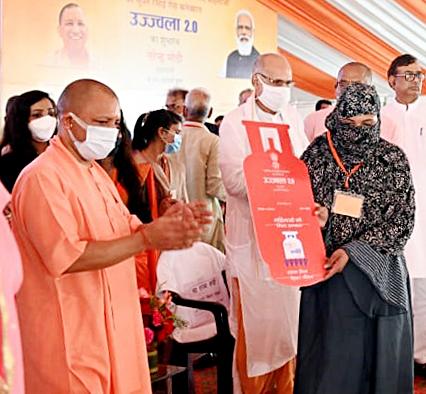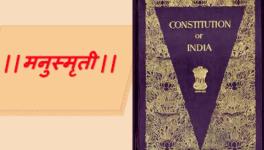Is there a ‘Labharthi’ Varg in Uttar Pradesh?

Voting is over in all but one phase of the Uttar Pradesh election, and just after the midway mark, the phrase “labharthi varg” suddenly started getting around. According to the Bharatiya Janata Party (BJP) ruling the state, this section of voters will determine the outcome of the ongoing election. According to its leaders, numerous pro-poor schemes and Direct Benefit Transfers have endeared the party and its government among people.
The BJP claims it launched Pradhan Mantri Awas Yojana for home-building; Swachh Bharat Abhiyan to build a toilet in every home; PM-KISAN to provide farmers three ₹2,000 instalments a year; and Ujjwala Yojana for free LPG gas connections. At least three of these schemes—Ujjwala, PMAY and Swachh Bharat—predate the victory of the BJP in the 2014 election nationally and 2019 in Uttar Pradesh. Therefore, previous regimes at the Centre and states created the labharthi varg or welfare beneficiary category.
The next question is whether the claim of BJP leaders that welfare schemes have worked wonders for it are accurate. Any project takes time before its implementation picks up on the ground. The initial phase includes planning, design, determining eligibility, approvals and budget allocation. These steps take the most time before the rollout begins. Over time, the pace of delivery picks up if all goes well. In the present context, the BJP confronts a mixed bag—while the rate of building Swachh Bharat toilets picked over 2016-19, scant attention is paid to the actual use of toilets and their condition, and gaps in coverage remain.
Similarly, the Ujjwala scheme has reached lakhs of homes, but a tripling of the cost of refilling cylinders compared with when the scheme began has had an adverse impact. Families have returned to using cow dung cakes or firewood as cooking fuel. Similar problems are pecking away at the successes the BJP claims in the PMAY.
Alongside these schemes is the free ration provision of the central government under the PM-GKAY or PM Garib Kalyan Anna Yojana. This scheme was implemented in five phases over roughly two years, from May 2020 to March 2022. However, official data reveals that the Department of Food and Public Distribution at the Centre allocated 68 lakh tonnes of rice and 71 lakh tonnes of wheat to Uttar Pradesh, but the off-take was only 47 lakh tonnes of rice and 60 lakh tonnes of wheat, a recent analysis by Newsclick found. After the COVID-19 crisis, the Uttar Pradesh government spent Rs. 900 crore a month on free dal, edible oil and salt to poor households. However, the gap in allocation and distribution indicates there is still a wide unmet need for staples in Uttar Pradesh households.
Patronage politics
Most welfare schemes are provided to citizens based on eligibility, as only a few are universal. Therefore, the grand category of labharthi varg can be seen as a means to unify the recipients—not all voters in the state—into a pro-government category. It is also presumptuous to think that all those who benefited from the government, particularly during the COVID-19 crisis, are a vote bank for the ruling party. That said, even Prime Minister Narendra Modi has made emotive appeals based on “Modi ka namak”.
The labharthi varg plank is a politically charged claim, aiming to generate a sense of gratitude among voters. It can be viewed as a response of the BJP to the defection of backward class leaders when this election campaign began. We do not know yet if this category will help it repeat the electoral feats the BJP achieved in 2017. Considering reports that the party’s performance was sub-par over the last five years, the rainbow coalition of backward classes, sections of Dalits and the Samajwadi Party’s traditional voters can dent the popularity of the ruling party’s divisive Hindutva plank.
The Yogi Adityanath government faces anti-incumbency for unsatisfactory performance, especially on the social justice front. Caste pride among the Rajputs and allegations of favouritism against the administration have produced anxiety amongst the non-elite castes. Irregularities and deficiencies in implementing the reservation policy in government recruitment have aggravated the turn away from the BJP.
These collective dents have made it essential for the party to talk about welfarism, but observers of this election say the distribution of benefits, especially cash, also polarises the electorate. For example, many feel that the government should provide gainful employment, not “benefits”. In caste-ridden Uttar Pradesh, welfare schemes benefit the poor who fall within the lower end of the caste hierarchy. Many BJP supporters would characterise its welfare provisions as unnecessary “hand-outs”, not serving essential needs. That could explain why the BJP is harping on having worked without “bhed-bhev” or discrimination.
The talk about labharthi conceals another profound message.
The BJP is striving to create a patronage network amongst welfare recipients, who predominantly belong on the lower echelons of the social hierarchy. This is nothing but clientism, with which the party perhaps hopes to bridge the caste-class boundary. This could be its weapon to counter the challenge posed by the Opposition alliance to hegemonic Hindutva. The BJP got a popular vote of just under 40% in the 2017 Assembly election. The near-total consolidation of upper caste voters combined with the subaltern caste groups made this possible. In other words, now it is attempting to categorise citizens as beneficiaries first—not members of any caste or class—and then declared loyal votaries of the incumbent regime.
In this sense, the labharthi varg is a product of neo-liberal economics, where the state does not intervene to mitigate social inequality nor recognises the universal social rights of citizens. Instead, welfare is “targeted” to complement the rampant expansion of the market economy. Scholars such as Partha Chatterjee have examined how targeted welfare programmes can be recast as a populist practice. In the present day, this populism comes hand-in-hand with Hindutva.
Opportunity cost of being a labharthi in Uttar Pradesh
In his double-engine ki sarkar (BJP governments at the Centre and state) slogan, the Prime Minister features pro-poor welfarism with a populist touch. But what is the opportunity cost of becoming a member of this labharthi varg? When the state recedes from the economic realm, and there are massive cuts in public expenditure, structural violence on the poor increases. Uttar Pradesh has the lowest level of employment, decreasing from 38% of the working population in 2016 to 32.79% in 2021. Unemployment amongst the educated youth has almost quadrupled in Uttar Pradesh. The state is also falling back on poverty, with around 38% of the population poor in the National Multidimensional Poverty Index (MPI), 2021, calculated using health, education and standard of living indicators. The state of public education is poor with low budget allocations and rampant vacancies in teaching posts.
Uttar Pradesh also ranked the lowest in the NITI Aayog’s Healthy States, Progressive India report. Data shows that the Gross State Domestic Product grew 1.95% per annum during the current regime, compared with 6.92% in 2012-17 under the previous state government. Agrarian distress and loss of income are widespread, especially among farmers, contrary to the promised doubling of farm incomes.
Overall, the five-year rule of the BJP failed to deliver government jobs and health facilities, focusing almost exclusively on the communal agenda. Now, the labharthi varg is the BJP’s strategy to establish a new relationship with citizens, where they are reduced to loyal welfare recipients and risk losing equality, redistributive economic policies and meaningful employment. But the wider interventions of the BJP are suited to the market, not people, and it is this that the challengers to the BJP are trying to point out when they promise permanent recruitment in vacant government posts, free electricity, etc. Which one of these clicks with voters, we will know on 10 March.
The author works as a researcher for Greenpeace. The views are personal.
Get the latest reports & analysis with people's perspective on Protests, movements & deep analytical videos, discussions of the current affairs in your Telegram app. Subscribe to NewsClick's Telegram channel & get Real-Time updates on stories, as they get published on our website.























